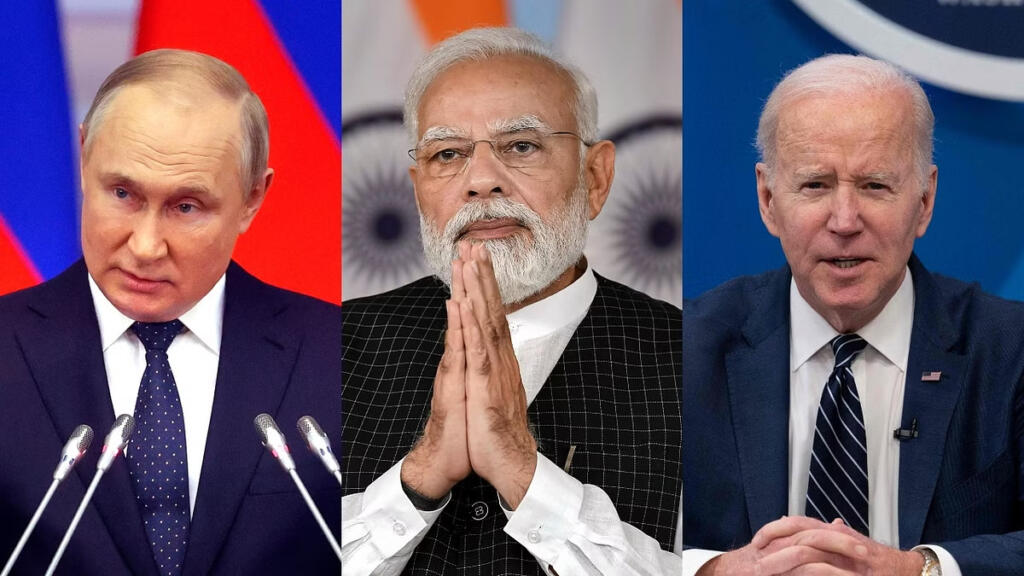Prime Minister Narendra Modi is on his Moscow trip on 8th and 9th July, where he participated in a summit meeting with Russian President Vladimir Putin. This image is one Western nations do not want to see due to the ongoing Russia-Ukraine war. Modi chose Russia for his first bilateral trip of his third term, sending an important message to Western leaders concerned about instability in Europe.
For the West
Since the invasion of Ukraine in 2022, Western alliances, spearheaded by the United States, have isolated and imposed sanctions on Putin’s Russia. Prime Minister Modi’s inaugural Moscow meeting with Putin post-Ukrainian aggression underscores India’s steadfast dedication to preserving its strategic independence. This signals to Western nations that India remains resolute in charting its foreign policy course, unswayed by external pressures, and seeks to maintain balanced relations amidst global geopolitical shifts.
India-US Relations: Strengths and Challenges
Despite special relations, there are tensions between India and the United States on some issues. America needs India in the Indo-Pacific, and India needs America for trade and defense technology. However, there has been some cooling in relations due to sensitive issues such as the Kashmir-Pannu case.
US Internal Intervention
The US State Department’s Religious Freedom Report for 2023 mentioned attacks on Muslims and Christians in India, which India promptly rejected as biased and lacking understanding of India’s social dynamics. This American intervention equals interference in India’s internal policies.
Balancing Act between Moscow and Washington
America is wary of the potential resurgence of the Russia-India-China (RIC) trilateral. While Moscow seeks to institutionalize RIC summits annually, ongoing tensions between India and China cast doubt on the feasibility of such a revival in the foreseeable future, posing challenges to American strategic interests in the region.
India’s Direction and National Interest
India does not want to come too close to the Russia-China axis. India is also concerned about Moscow’s attempt to expand BRICS, which could weaken India’s position. India wants to establish itself as a balancing point between the interests of America and the China-Russia alliance.
2030 Perspective
By 2030, India is projected to achieve a $7 trillion economy, significantly boosting its per capita income to approximately $5,500 in nominal terms and $12,000 in Purchasing Power Parity (PPP). This economic advancement is poised to elevate India’s global influence, allowing it to assume a pivotal role in international affairs. This growth underscores India’s potential to shape global economic dynamics and reinforces its position as a key player in the evolving geopolitical landscape.
Economic Aspect of Moscow Trip
In Moscow, Modi will gain direct insights into the Ukraine conflict. Despite this, Russia’s economy is growing at a rate of more than 3% per year, faster than most European economies. India now buys half of its crude oil from Russia and rupee-ruble trade is increasing. This step aligns the interests of both countries away from dollar-dependent global economies.
Message of Strategic Autonomy
Modi did not attend the Shanghai Cooperation Organization (SCO) summit in Kazakhstan last week, sending Foreign Minister Jaishankar instead, while Xi Jinping and Putin were present at the summit. This step was a message of strategic autonomy for both the West and Moscow-Beijing alliances.
Conclusion
Prime Minister Modi’s Moscow trip and meeting with Putin send a strong message to the West. It demonstrates India’s commitment to its strategic autonomy and safeguarding its national interests. This trip also highlights India’s efforts to maintain a balance in its relations with America and Russia, which will play a significant role in global politics in the future.
ALSO READ: Maldives Ministers Detained for Alleged Use of Black Magic Against President Muizzu
